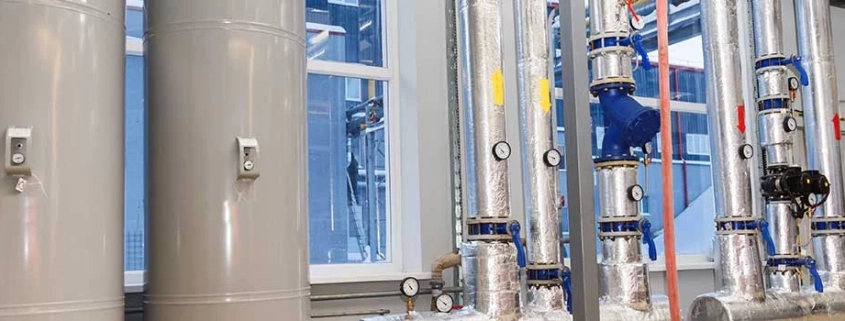Boiler Room Gas Detection Systems
Most gas boiler room It operates without constant monitoring and a gas leak can go unnoticed. For boiler room gas detection controllers It essentially eliminates these risks by triggering the valve actuators. In case of flammable gas detection (liquefied petroleum gas or natural gas), a controller shuts off the gas supply with a safety solenoid valve (instruments located inside taps with appropriate fittings) located upstream and, if possible, outside the technical room.
Boiler rooms standards and regulations
Gas detection systems in large boiler rooms are subject to certain regulations but common sense dictates that the same recommendations apply to smaller systems, regardless of the sector of activity. Gases lighter than air (e.g. methane – CH4 For CH4– etc. the device must be placed above the burner; For gases heavier than air (such as butane or propane), a multi-gas detector should be placed under the burner.
In gas boiler rooms with high ceilings (higher than 3 meters), an additional gas detector is placed at the highest point of the boiler room (or preferably at the exhaust inlet stream, if present); thus, double detection (burner and ceiling) is achieved regardless of the number of burners (hydrogen or other fuel boilers).
All tools required to operate boiler room equipment are referenced according to applicable standards and regulations. The decree of 23 June 1978 applies to boiler rooms with a capacity of more than 70 kW or 85 kW and boiler rooms with a capacity of up to 2000 kW and less than 2 MW. Page 2910 of the order dated 3 August 2018 establishes new methods by reducing the classification threshold for Installations Classées Protection de l’Environnement to 1 MW. This change makes it mandatory to install a fixed gas detection device in boiler rooms.
Boiler room gas detection: different alarm thresholds
Boiler room gas detection: different alarm thresholds
- Level 1: 10% or 15% of LEL (lower explosion limit), with alarm notification for rapid response in a hazardous area visual and audio signal
- Level 2: Between 20% and 40% of LEL, by manual resetting of the boiler gas valve interruption of gas supply (human intervention required to restart the boiler)
- Level 3: Only for the largest gas boiler heating systems. Starting from 60% of LEL, direct action on main LV board and complete shutdown of any power source (except the boiler room gas sensing controller)
Another type of boiler room
Industrial steam boiler room, It is very popular in food, metal, chemical and other industries. At a time when we are looking for a better way to reduce our energy bills, this type of heating meets today's challenges by being more ecological and environmentally friendly. To achieve results, like water and gas consumables It is essential to monitor its evolution. Maintenance and control of the equipment is also essential for the proper operation of the steam boiler. In houses equipped with boilers, carbon monoxide emission risk cannot be ignored.
Gas detectors in boiler rooms
The gas detector inside a boiler room housing several boilers, connected to a central gas detection system, is an important element in worker protection. Daily The use of high-tech detection equipment that requires impact testing is important to the proper functioning of a boiler room. It warns of leaks in gas-fired boiler rooms early and helps protect workers from possible explosions or poisoning. Some for explosive, toxic and refrigerant gases Suitable for ATEX zones such as the OLCT100 fixed gas detector.
The number of devices to be installed depends on the number of boilers, and their location in the building is determined by the risk of leakage. One detector per boiler is preferred, with a central detector at the top, which is lighter than air due to the weight of natural gas, and a device above the heating equipment to trap the gas. The bottom of the system features a ventilation system with fresh air intake, while the top features an air exhaust system to provide continuous air purification even when the burners are turned off.
Maintenance of all tools used in boiler room gas detector is essential. Personnel must be available regularly to perform manual checks, calibrations and preventive maintenance. An explosive meter sensor should be inspected and calibrated periodically. For portable gas detectors, a docking station is ideal for daily crash testing to check that the sensor and cells are working properly.
Components for AIR/GAS lines in boiler rooms
The main (and most effective) form of control in the event of an unexpected gas supply is a device, preferably with automatic or manual reset. gas solenoid valve is to cut off the gas supply using . The power supply of the product passes through the gas detection control unit (fail-safe relay), which shuts down in the event of an alarm as soon as a voltage deficiency is detected. This gas cut-off ensures optimum safety.
gas line accessories Offers advanced protection for solenoid valves. The two basic safety products are block valves, which stop the flow of gas at a certain point, and gas pressure switches, which measure the minimum presence of gas or overpressure. A solenoid valve is an aluminum or brass fitting that opens or closes a circuit by sending an electric current through a magnetic field. They usually have female-to-female connections to standard flanges. This range of tools is diverse and affordable.
The pressure gauge is also a good complement. It measures the pressure of a liquid or gaseous fluid in a heating system. Regular readings of the level are required to detect any problems in the atmosphere .
Dead glass box is an excellent safety accessory that protects the solenoid valve from corrosion.


